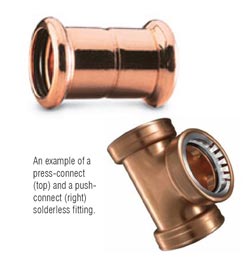Cold Fusion: Joining Copper Plumbing Without Heat
Soldering and brazing have always been the industry standard for joining copper tube and fittings, but recent innovations in solderless or "flameless" connection methods promise to change the way copper plumbing systems are designed and built, now and in the future.
Various types of solderless systems that do not require heat, solder or flux materials have been available since 1925. However, the new systems, which utilize push-connect or press-connect fittings, are the first to imitate closely the compact, inexpensive, ease-of-use of standard, compact, inexpensive, soldered copper fitting.
Solderless push-connect and press-connect systems can be used for most plumbing applications including cold and hot water distribution, hydronic heating and cooling, compressed air, inert gases and fuel gas systems. Joints made using these systems are capable of withstanding the pressure and temperature ranges common to both residential and commercial building systems, and fittings are available in standard diameters from one-half inch to two inches and larger.
 High-resolution version of this photo.
High-resolution version of this photo.There are many benefits to using solderless fittings. Joints can be made with water in the tubing, making them ideal for emergency repairs. Unlike soldered and brazed joints, solderless connections can be pressure-tested immediately after the joint is fabricated. Because flame is not used, burn permits or a "fire watch" are not necessary during installation. More importantly, system modifications can be made without fear of discoloration or damage to nearby building finishes or components.
There are potential cost savings as well. While solderless fittings are more expensive than standard fittings, the work of joining and testing go faster; which can provide significant reductions in labor costs. Also, as more plumbers adopt the new systems, competition among manufacturers and economies of scale should help to reduce the cost of materials and tools.
In press-connect solderless systems, fittings with integral O-rings are placed onto the copper tubing and a special tool is used to clamp them permanently in place. Different systems are available with O-rings at the center of the fitting socket or close to the end of each opening. The tools required typically can be used only with one brand of fittings.
Push-connect systems do not require special tools to make the connections, and in some cases can be easily removed and reinstalled without damaging the connection. The copper tubing is inserted into the fitting until it engages a retaining ring that grips it tightly. Elastomeric gaskets at each end of the fittings further compress the fitting to the tube. Fittings have internal stops or sleeves and washers to aid in positioning and aligning the tubing.
Solderless fittings are expected to continue to attract converts among plumbing and piping professionals looking for another tool in their bag to optimize their installation of copper piping systems. With the variety of quality joining options available, soldered, brazed, compression, grooved and the new push-connect and press-connect joining systems, there is no more adaptable, long lasting and reliable piping system than copper.
Also in this Issue:
- Copper: Architecture’s Green ‘Enabler’
- Copper: An Element of Good Design
- Copper Rx for Sick Buildings
- Austin City Hall Goes Green with Copper
- Cold Fusion: Joining Copper Plumbing Without Heat
